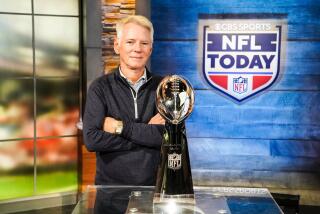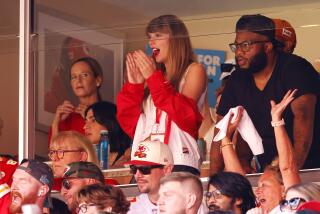Minneapolis: Capital City of U.S. Sports
- Share via
Let’s face it. If Minneapolis were a media capital, Lou Grant never would have left WJM for a newspaper job in Los Angeles. For that matter, the city that calls itself the “Miniapple” isn’t even a state capital, the honor having been awarded to its twin, St. Paul, when Minnesota was admitted to the union in the 19th Century.
But what it is today and what it will remain until at least the first week in April, 1992, is the sports capital of the nation. No athletic team from the immediate vicinity has claimed a championship of any kind in the past three years, but the city and region have scored some remarkable triumphs nonetheless. The result is an economic and public relations coup that transends anything in United States sports history.
Consider that the Stanley Cup was placed on display in suburban Bloomington in May when the local NHL club unexpectedly barged into the finals. One month later, the U.S. Open golf tournament was staged at Hazeltine in nearby Chaska. The Twins, last in the American League West in 1990, lead the division and are hopeful of returning the World Series to the Humbert H. Humphrey Metrodome, where the 1987 classic started and finished. Moreover, that all-purpose facility will host not only the 1992 Super Bowl on Jan. 26 but the 1992 NCAA basketball championships on April 4-6.
On top of all that activity, the city continues to be praised for the financial and emotional support it lent to the 1990 U.S. Olympic Festival, especially in wake of the yawns the event inspired in Los Angeles this summer. A total of 6,000 athletes from 91 countries now are competing in the Special Olympics there. And the NCAA has assigned the 1995 women’s Final Four to Minneapolis.
This is heady stuff for the smallest city in the nation to boast franchises in all four major team sports, for a city that was without a big-league franchise of any kind in 1960 after the Lakers fled west with Elgin Baylor and settled down, most inappropriately, in parched southern California. The Twins and Vikings both moved into Metropolitan Stadium in Bloomington a year later and the sports revival was on. But nothing could have prepared citizens for the 12-month period that started in May with the NHL finals.
According to Dick Mona, an advertising executive whose firm -- Mona, Meyer and McGrath -- coordinated the winning bids for the Super Bowl and Final Four, the city’s “championship season” was an outgrowth of national interest stirred for the first time at the 1985 All-Star Game. It increased two years later when the Twins thoroughly surprised baseball by qualifying for the World Series, which it won in seven games over the St. Louis Cardinals.
“There was a special feeling that year,” Mona said. “Everyone wrote about the city that never wins and recycled those stories about Humphrey, McCarthy, Mondale and the Vikings. And then the Twins won.”
By then, the city already had made one bid for the Super Bowl. Just like its National Football League team, which is 0-4 in championship games, the city lost.
“We became aware that in 1984 the NFL was going to make multiple awards,” Mona recalled, “so we went and blew our brains out trying to attract attention. We put out a beautiful book on the area and its attractions. We were awarded ‘Best of Show.”’
The league did commend the Minneapolis task force for its efforts and sent the group home empty-handed. It was at that point that Mike Lynn, then the executive vice president and general manager of the Vikings, advised the task force it never would win a competition against the likes of a New Orleans. He did his part by introducing a motion that the Super Bowl be awarded to a northern city once every seven-to-10 years.
As a consequence, Minneapolis’ rivals for the 1992 game included Seattle, Indianapolis and Pontiac, Mich., site of the inaugural Freezer Bowl in 1982. Although the Minnesota city is noted for the most extreme temperatures of the group, it also is best equipped to deal with a harsh winter. The Metrodome is within walking distance of hotels, department stores and cultural centers and the city’s unique skyway system enables pedestrians to walk miles in heated, glass-enclosed walkways.
“We’re calling it a ‘party under glass,”’ Mona said. And for those who want to get out and revel in the snow, he added, there will be transportation to the St. Paul Winter Carnival. The army of volunteers at work on the Special Olympics will have plenty of practice for the Super Bowl and for the Final Four.
The latter actually was awarded to Minneapolis before the Super Bowl. That they are scheduled 10 weeks apart in the same building is not the result of some grand plan. “It’s pure coincidence,” said Mona, a member of the organizing committee for both events. “But none of this could have happened without the Dome.”
Although the facility may be unloved by baseball traditionalists and outfielders, who have the darndest time tracking a fly ball against the background of a light roof, there’s no question it has done wonders for the vitality of the region. The Minnesota Timberwolves set an NBA attendance record therein in their first year of play. They since have moved to a new 18,500-seat arena, the Target Center, on the west side of town.
And if the lowly North Stars could advance to the Stanley Cup finals and the Twins become the first team in history to vault from last to first, the argument goes, imagine what the T-Wolves might accomplish under new Coach Jimmy Rodgers. If art imitates life, perhaps we should expect television’s favorite coach, Hayden Fox, to lead Minnesota State to the Rose Bowl in January.
More to Read
Go beyond the scoreboard
Get the latest on L.A.'s teams in the daily Sports Report newsletter.
You may occasionally receive promotional content from the Los Angeles Times.










